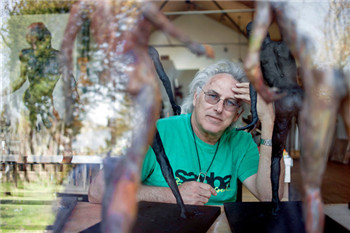
The artist Eric Fischl remembers the time a friend waved a catalog at him to alert him that one of his paintings was up for auction for six figures in London. In reality, the work was a fake, but so convincing, Mr. Fischl said, “I thought I was losing my mind.”
艺术家埃里克·菲施尔(Eric Fischl)还记得,有一次一位朋友对他挥舞着拍卖目录,说他的一件绘画作品以数十万美元的估价在伦敦拍卖。而实际上,那幅画是赝品,但是跟原作很像。菲施尔说,“当时我都要疯了。”
Brushes with forgery like that one two decades ago, and concerns about his legacy and estate, prompted Mr. Fischl to appear in London on Monday to vouch for a new authentication system that would let artists sign their works with specks of synthetic DNA.
20年前的那幅赝品以及对自己遗产和财产的担忧促使菲施尔于周一(10月12日)出现在伦敦,支持一个新的认证系统,它将让艺术家们用少量合成的DNA给自己的作品签名。
The method is being developed at the Global Center for Innovation at the State University of New York at Albany. The school said it had received $2 million in funding from the ARIS Title Insurance Corporation, which specializes in art.
纽约州立大学奥尔巴尼分校的全球创新中心(Global Center for Innovation)正在研发这种技术。该校称,它得到了阿里斯产权保险公司(ARIS Title Insurance Corporation)200万美元的资助。该公司专门为艺术品提供保险。
Two years ago, the center, known for its work in bioengineering, encryption and nanotechnology, set about developing a way to infuse paintings, sculptures and other artworks with complex molecules of DNA created in the lab.
两年前,以生物工程、加密技术和纳米技术闻名的全球创新中心开始研发一种技术,给绘画和雕塑等艺术品注入在实验室里创造的复杂DNA分子。
“We wanted a marker that was very hard to locate and not prone to environmental issues or tampering,” Robert J. Jones, president of SUNY Albany, said. Equally important, he added, was that artists would embrace the approach.
“我们想创造一种标记,它很难定位,不易受环境因素影响,不易篡改,”纽约州立大学奥尔巴尼分校的校长罗伯特·J·琼斯(Robert J. Jones)说。他补充说,同样重要的是,艺术家们能接受这种方式。
Experts say fakes have become one of the most vexing problems in the art market. Scandals like the one involving dozens of forgeries sold through the venerable Knoedler Gallery in Manhattan before it closed in 2011 are sapping the confidence of buyers, owners and artists, they say.
专家们说,赝品已成为艺术市场最恼人的一个问题。曼哈顿备受尊敬的诺德勒美术馆(Knoedler Gallery)在2011年倒闭之前,曾卖出几十件赝品。专家们说,这样的丑闻在打击买家、所有者和艺术家的信心。
An objective way of marking art would be particularly attractive at a time when reliance on subjective expertise, or connoisseurship, and often-incomplete provenance, seems to be waning. Curators, artists’ foundations and independent experts now often shy away from authenticating works for fear of being sued.
如今,人们不再信赖主观的专家鉴定和往往不完整的来源证明。所以,这种对艺术品进行标记的客观方式尤为吸引人。现在,策展人、艺术家基金会和独立专家经常因为担心遭到起诉而拒绝进行艺术品鉴定。
“There is a deep freeze in authentications,” said Colette Loll of Art Fraud Insights, who was a consultant on the project.
“人们现在非常不愿意进行艺术品鉴定,”艺术品诈骗洞察组织(Art Fraud Insights)的科莱特·洛尔(Colette Loll)说。她是这一项目的顾问。
But while automobiles, for example, have vehicle identification numbers, works by living artists enter the market without dependable standards of identification.
比如,汽车有车辆识别码,但是在世艺术家们的作品进入市场时却没有可靠的鉴定标准。
The new approach, in its formative stage, would implant synthetic DNA, not the personal DNA of the artists, because of privacy issues and because a person’s DNA could conceivably be stolen and embedded, thus undermining the authority of such a marking protocol.
这种处于研发阶段的新方法将植入合成DNA,而非艺术家本人的DNA,一方面是为了保护艺术家的隐私,另一方面是个人DNA可能会被窃取和植入,从而损害这种防伪手段的可信性。
The developers said the bioengineered DNA would be unique to each item and provide an encrypted link between the art and a database that would hold the consensus of authoritative information about the work. The DNA details could be read by a scanner available to anyone in the art industry wanting to verify an object.
开发者们说,这种用生物工程技术合成的DNA将是每件作品独一无二的标记,能在艺术品和数据库之间建立一种加密关系。这个数据库将持有每件作品的权威信息。艺术界的任何人若想验证一件作品,都可以通过扫描获得DNA细节。
Those trying to create the new standard said they had signed up three dozen internationally recognized artists, archives, foundations and museums who want to test the technology, which could be ready as early as next year.
尝试创立新标准的人说,他们已与36个想要测试这一技术的国际知名艺术家、档案馆、基金会和博物馆签订了协议。最早于明年,这项技术将完成开发。
Artists and owners would buy a kind of tag that they could use to apply the DNA. Early estimates by the developers say tags would cost about $150. Once applied, the DNA would penetrate the work at the molecular level, so removing the tag would not eliminate the item’s forensic signature.
艺术家和所有者需要购买一种用以植入DNA的标签。据开发者初步估计,标签的费用约为150美元。一旦植入,这种DNA将在分子水平渗透到作品中,所以去除标签也不会影响它的法律效力。
“We see it as a secure, safe and invisible solution that artists and owners can accept,” said Lawrence M. Shindell, chairman of ARIS, which is based in New York. “Our goal is to remove uncertainty from the market.”
“我们认为它是艺术家和所有者能够接受的安全可靠且不露痕迹的解决方案,”住在纽约的阿里斯产权保险公司主席劳伦斯·M·欣德尔(Lawrence M. Shindell)说,“我们的目标是消除市场上的不确定性。”
Potential buyers and sellers could also check items for DNA codes to see whether the items had been stolen. Doing so could block their resale by galleries and auctioneers and bring about their recovery, the supporters said.
潜在买家和卖家还可以通过检验DNA来确定某件作品是否是赃物。这项技术的支持者们说,这样做可以避免赃物被画廊和拍卖行转卖,使作品物归原主。
They said it was crucial that applying the tags have no impact on the work.
他们说,关键是,加上这种标签不会对作品造成任何损害。
Deciphering and replicating the DNA would be all but impossible, according to Mr. Shindell. He said even sophisticated counterfeiters “would leave microscopic forensic evidence” if they tried to remove or replace the DNA.
欣德尔说,破解和复制这种DNA几乎是不可能的,在移除或替换DNA时,甚至连高明的伪造者“都会留下细微的法律证据”。
Mr. Jones said SUNY took on the task as a public service and a possible revenue generator, though those details remain unclear. ARIS said it had no ownership of the technology, but would benefit from the greater transparency and confidence in a $55-billion-a-year market in which it sells insurance.
琼斯说,纽约州立大学承担这一任务是为了公益,也是为了获得潜在的收益,不过这些细节仍不明确。阿里斯产权保险公司说,这项技术不归它所有,但是如果这个年交易额高达550亿美元的市场能够变得更透明,让人更有信心,那么作为这个市场的保险提供者,阿里斯公司也将从中获益。
“It makes a lot of sense for us to be involved given that the state of New York is one of the world’s largest art markets,” Mr. Jones said. “We hope there will be financial benefits from creating the intellectual property and the process becomes a gold standard in the industry.”
“纽约州是世界上最大的艺术品市场之一,所以我们参与进来很是合乎情理,”琼斯说,“我们希望通过创造知识产权获得经济收益,也希望这种鉴定方法能成为该行业的黄金标准。”
Mr. Fischl said he wanted to assure fellow artists that the idea is “a no-brainer” for preventing forgeries of their work from being sold. He added that “authenticating a work from the very start can alleviate the pain and frustration people go through when they think they have something of great value and they really don’t.”
菲施尔说,他想让其他艺术家们也认识到,这种方法“很简单”,可以防止赝品被售出。他补充说,“从一开始就对作品进行认证能避免人们以为自己拥有很有价值的东西而事实并非如此所带来的痛苦和沮丧。”
“What’s not sexy about synthetic DNA?” he added.
“合成DNA有哪一点不迷人呢?”












